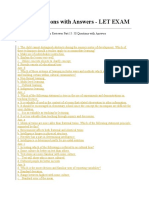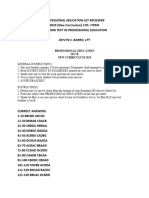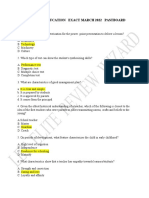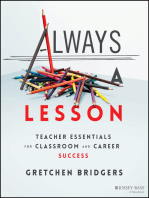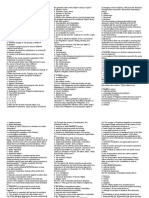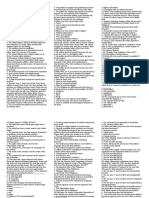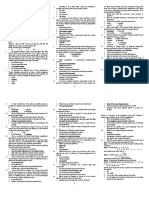Prof Part 6
Prof Part 6
Uploaded by
Jane Uranza CadagueCopyright:
Available Formats
Prof Part 6
Prof Part 6
Uploaded by
Jane Uranza CadagueOriginal Title
Copyright
Available Formats
Share this document
Did you find this document useful?
Is this content inappropriate?
Copyright:
Available Formats
Prof Part 6
Prof Part 6
Uploaded by
Jane Uranza CadagueCopyright:
Available Formats
More LET Reviewers here: https://letqa.blogspot.
com/
Prof.Ed Part 6
1. Which of the following are effective methods in teaching student critical reading skills?
I. Interpret editorials
II. Read and interpret three different movie reviews
III. Read a position paper and deduce underlying assumptions of the position papers
a. II and III c. I and II
b. I and III d. I, II and III
Ans: d
2. Here is a test item:
“The improvement of basic education should be the top priority of the Philippine government. Defend and refute the position.”
Under what type of question does this test item fall?
a. Low-level c. Analysis
b. Evaluative d. Convergent
Ans: b
3. Teacher Jenny teaches a lesson in which students must recognize that ¼ is the same as 0.25. They use this relationship to determine that
0.15 and 0.20 are slightly less than ¼. Which of the following concept/s is/are being taught?
a. Numeration skills
b. Place value of decimals
c. Numeration skills for decimal and relationship between fractions and decimals
d. Relationship between fractions and decimals
Ans: c
4. To nurture student’s creativity, which activity should the teacher avoid?
a. Ask “what if” questions
b. Ask divergent thinking questions
c. Emphasize the need to give right answer
d. Be open to “out-of-this world” ideas
Ans: c
5. After reading an essay, Teacher Bebe wants to help sharpen her students’ ability to interpret. Which of these activities will be most
appropriate?
a. Drawing conclusions
b. Making inferences
c. Getting the main idea
d. Listing facts separately from opinion
Ans: b
6. What is the best way to develop math concepts?
a. Solving problems using multiple approaches
b. Solving problems by looking for correct answer
c. Learning math as applied to situations such as being a tool of science
d. Solving problems by applying learned formulas
Ans: c
7. Teacher Cita, an experienced teacher, does daily review of past lessons in order to ________.
a. Provide her pupils with a sense of continuity
b. Introduce a new lesson
c. Reflect on how she presented the previous lesson
d. Determine who among her pupils are studying
More LET Reviewers here: https://letqa.blogspot.com/
More LET Reviewers here: https://letqa.blogspot.com/
Ans: a
8. Research says that mastery experiences increase confidence and willingness to try similar or more challenging tasks such as reading. What
does this imply for children reading performance?
a. Children who have mastered basic skills are more likely to be less motivated to read because they get fed up with too much reading
b. Children who have not mastered the basic skills are more likely to be motivated to read in order to gain mastery over basic skills
c. Children who have a high sense of self-confidence are not necessarily those who can read
d. Children who have gained mastery over basic skills are more motivate to read
Ans: d
9. Bruner’s theory on intellectual development moves from enactive to iconic and symbolic stages. Applying Bruner’s theory, how would you
teach?
a. Begin with the abstract
b. Be interactive in approach
c. Begin with the concrete
d. Do direct instruction
Ans: c
10. Teacher Nene asked this question: “What conclusion can you draw based on your observation?” Nobody raised a hand so she asked another
question: “Based on what you observe, what can you now say about the reaction of plants to light.” What did Teacher Nene do?
a. Redirecting c. Repeating
b. Probing d. Rephrasing
Ans: d
11. Under no circumstance shall a teacher be prejudiced nor discriminatory against any learner according to the Code of Ethics. When is a
teacher prejudice against any learner?
a. When he makes a nearsighted pupil sit at the front
b. When he considers multiple intelligences in the choice of his teaching strategies
c. When he makes a farsighted pupil sit at the back
d. When he refuses a pupil with a slight physical disability in class
Ans: d
12. Which learning activity is most appropriate if teacher’s focus in attitudinal change?
a. Role play c. Exhibit
b. Field trip d. Game
Ans: a
13. The mode of a score distribution is 25. This means that:
a. There is no score of 25
b. Twenty five (25) is the score that occurs most
c. Twenty five is the average of the score distribution
d. Twenty five is the score that occurs least
Ans: b
14. The following characterize a child-centered kindergarten except:
a. Focus on the education of the whole child
b. Importance of play in development
c. Extreme orientation on academic
d. Emphasis on individual uniqueness
Ans: c
More LET Reviewers here: https://letqa.blogspot.com/
More LET Reviewers here: https://letqa.blogspot.com/
15. As a classroom manager, how can you exhibit expert power on the first day of school?
a. By citing to my students the important of good grades
b. By making my students feel my authority over them
c. By making them feel a sense of belongingness and acceptance
d. By making my students feel I know what I am talking about
Ans: d
16. Which may help an adolescent discover his identity?
a. Parents pushing in to follow a specific path
b. Relating to people
c. Decision to follow one path only
d. Exploring many different roles in a healthy manner
Ans: d
17. Which terms refers to a teacher helping a colleague grow professionally?
a. Technology transfer
b. Peer mentoring
c. Facilitating
d. Independent study
Ans: b
18. What primary criterion should guide a teacher in the choice of instructional devices?
a. Novelty c. Appropriateness
b. Cost d. Attractiveness
Ans: c
19. Some of your students don’t seem to like you as their teacher. If you will regard the situation, on the level of the ego, what will you most likely
think about?
a. Why should I care if they like me or not
b. To hell with them
c. What’s wrong have I done to deserve this?
d. What is it about me that they do not like?
Ans: d
20. Which of the following is considered a peripheral device?
a. Printer c. CPU
b. Keyboard d. Monitor
Ans: a
21. Which questioning practice will promote more class interaction?
a. Asking rhetorical question
b. Rejecting wrong answer
c. Focusing on convergent question
d. Asking divergent question
Ans: d
22. For grades to be (made) valid indicators of students’ achievements, which process should be observed?
a. Adopting letter grades such as A, B, C, D
b. Explaining the meaning of grades
c. Defining the course objectives as intended learning outcomes
More LET Reviewers here: https://letqa.blogspot.com/
More LET Reviewers here: https://letqa.blogspot.com/
d. Giving objective type of test
Ans: c
23. The claim of a benefactor to the gratitude of his protégé is an example of a (an):
a. Acquired right c. Imperfect right
b. Perfect right d. Alienable right
Ans: c
24. Which appropriate teaching practice flows from this research finding on the brain: “The brain’s emotional center is tied its ability to learn.”
a. Create a learning environment that encourages students to explore their feelings and ideas freely
b. Come up with highly competitive games where winners will feel happily
c. Establish this discipline of being judgmental in attitude
d. Tell the students to participate in class activities or else they won’t receive plus points in class recitation
Ans: a
25. Research on Piagetian tasks indicates that thinking becomes more logical and abstract as children reach the formal operations stage. What
is an educational implication of this finding?
a. Expect hypothetical reasoning for learners between 12 to 15 years of age
b. Learners who are not capable of logical reasoning from ages 8 to 11 behind in their cognitive development
c. Engage children in analogical reasoning as early as preschool to train them for higher order thinking skills (HOTS)
d. Let children be children
26. A mathematics test was given to all Grade V pupils to determine the contestants for the math quiz bee. Which statistical measure should be
used to identify the top 15?
a. Percentage score
b. Mean percentage score
c. Quartile score
d. Percentile score
Ans: a
27. Which is the true foundation of the social order?
a. Strong, political leadership
b. The reciprocation of rights and duties
c. Equitable distribution of wealth
d. Obedient citizenry
Ans: b
28. With which is true authority equated?
a. Service c. Suppression
b. Power d. Coercion
Ans: a
29. The following are sound specific purposes of questions except:
a. To stimulate learners to ask questions
b. To call the attention of an inattentive student
c. To arouse interest and curiosity
d. To teach via student answers
Ans: b
30. What is not a sound purpose in making questions?
a. To remind students of a procedure
b. To probe deeper after an answer is given
More LET Reviewers here: https://letqa.blogspot.com/
More LET Reviewers here: https://letqa.blogspot.com/
c. To encourage self-reflection
d. To discipline a bully in class
Ans: d
31. A student passes a book report written but ornately presented in a folder to make up for the poor quality of the book content. Which Filipino
trait does this practice prove?
a. Art over science
b. Art over academic
c. Substance over “porma”
d. “Porma” over substance
Ans: d
32. Which one should a teacher avoid to produce an environment conducive for learning?
a. Games c. Tests
b. Seat plan d. Individual competition
Ans: d
33. Between pursuing a college course where there is no demand and a vocational course which is highly in demand, the Filipino usually opts for
the college course. Which Filipino trait is shown?
a. Interest to obtain a skill
b. Penchant for a college diploma
c. Desire for entrepreneurship
d. Appreciation of manual labor
Ans: b
34. Which of the following does extreme authoritarianism in the home reinforce in pupils?
a. Sense of initiative
b. Dependence on other for direction
c. Ability for self-direction
d. Creativity in work
Ans: b
35. Teacher Bart wants his students to master the concept of social justice. Which series of activities will be most effective?
a. Pre-teaching > posttest > re-teaching of unlearned concept > posttest
b. Pre-test > teaching > posttest
c. Review > pretest > teaching > posttest
d. Teaching > posttest
Ans: c
36. To provide for individual differences how is curriculum designed?
a. Minimum learning competencies are included
b. Realistic and meaningful experiences are provided
c. Some degree of flexibility is provided
d. Social skills are emphasized
Ans: b
37. Which types of play is most characteristic of a four- to six-year-old child?
a. Solitary and onlooker plays
b. Associative and cooperative plays
c. Associative and onlookers plays
d. Cooperative and solitary plays
More LET Reviewers here: https://letqa.blogspot.com/
More LET Reviewers here: https://letqa.blogspot.com/
Ans:b
38. How can you exhibit referent power on the first day of school?
a. By making the students feel you know what you are talking about
b. By telling them the importance of good grades
c. By reminding your students your authority over them again and again
d. By giving your students a sense of belonging and acceptance
Ans: d
39. To ensure that all Filipino children are functionally literate, which mechanism is meant to reach out to children who are far from a school?
a. A school in every barangay
b. Multi-grade classroom
c. Mobile teacher
d. Sine’s skwela
Ans: a
40. Referring to the characteristics of the latest Basic Educational Curriculum which does not belong to the group?
a. More flexible
b. Less prescriptive
c. More compartmentalized
d. More integrated
Ans: c
41. If student’s inappropriate behavior is low level or mild and that it appears that the misbehavior will not spread to others, it is sometimes best
for the teacher not to take notice of it. What influence technique is this?
a. Planned ignoring
b. Antiseptic bouncing
c. Proximity control
d. Signal interference
Ans: a
42. Which among the following objectives in the psychomotor domain is highest in level?
a. To distinguish distant and close sounds
b. To contract a muscle
c. To run a 100-meter dash
d. To dance the basic steps of the waltz
Ans: d
43. Which material consists of instructional units that cater to varying mental level pupils?
a. Plantilia
b. Multi-level materials
c. Multi-grade materials
d. Minimum learning competencies
Ans: b
44. Which statement on counseling is false?
a. For counseling to be successful, the counselee is willing to participate in the process
b. The ultimate goal of counseling is greater happiness on the part of the counselee
c. Counseling is the program that includes guidance
d. The school counselor is primarily responsible of counseling
Ans: b
More LET Reviewers here: https://letqa.blogspot.com/
More LET Reviewers here: https://letqa.blogspot.com/
45. Arianna describes Teacher Monica as “fair, caring and approachable.” Which power does Teacher Monica possess?
a. Legitimate power
b. Expert power
c. Referent power
d. Reward power
Ans: c
46. Kounin claims “with-it-ness” is one of the characteristics of an effective classroom manager. Which among the following is a sign of “with-it-
ness”?
a. Giving attention to students having difficulty with school work
b. Seeing only a portion of the class but intensively
c. Knowing where instructional materials are kept
d. Aware of what’s happening in all part of the classroom
Ans: d
47. In the K-W-L technique, K stands for what the pupils already knows, W for what he wants to know and L for what he:
a. Learned c. Failed to learn
b. He like to learn d. Needs to learn
Ans: a
48. When a significantly greater number from the lower group gets a test item correctly, this implies that the test item:
a. Is not highly reliable
b. Is not very valid
c. Is highly reliable
d. Is very valid
Ans: a
49. Which statement about guidance is false?
a. The classroom teacher is not part of the school guidance program since she is not trained to be a guidance counselor
b. Guidance embraces curriculum, teaching, supervision and all other activities in school
c. Guidance is a function of the entire school
d. A guidance program is inherent in every school
Ans: a
50. A teacher should not be a slave of his lesson plan. This means that:
a. A teacher must be willing to depart from her lesson plan if students are interested in something other than her intended lesson
b. A lesson plan must be followed by a teacher no matter what
c. A teacher must be ready to depart from her lesson plan if she remembers something more interesting than what she earlier planned
d. Teacher is the best lesson plan designer
Ans: a
More LET Reviewers here: https://letqa.blogspot.com/
You might also like
- Promoting Rigor Through Higher Level Questioning: Practical Strategies for Developing Students' Critical ThinkingFrom EverandPromoting Rigor Through Higher Level Questioning: Practical Strategies for Developing Students' Critical ThinkingNo ratings yet
- New York Trust LawDocument12 pagesNew York Trust Lawgenelunsford100% (7)
- ANALYTICAL PROF ED M2019 Ans KeyDocument18 pagesANALYTICAL PROF ED M2019 Ans KeyMark John Tanoja100% (4)
- LET Reviewer Prof EducationDocument39 pagesLET Reviewer Prof EducationBhong Libantino88% (60)
- Social Studies Major - Set B - Part 3Document3 pagesSocial Studies Major - Set B - Part 3Jane Uranza CadagueNo ratings yet
- Prof - Ed Part 14Document7 pagesProf - Ed Part 14Michael BalmesNo ratings yet
- 15: 50 Questions With Answers - LET EXAMDocument7 pages15: 50 Questions With Answers - LET EXAMTrixie Mae MarcellanoNo ratings yet
- 2018 Professional Education Reviewer Part 15Document10 pages2018 Professional Education Reviewer Part 15Michael BalmesNo ratings yet
- MCQ in Professional Education Part 6 - Licensure Exam For TeachersDocument19 pagesMCQ in Professional Education Part 6 - Licensure Exam For TeachersJuliana FormalejoNo ratings yet
- Prof. Ed HandoutDocument10 pagesProf. Ed HandoutMichael BalmesNo ratings yet
- Prof - Ed Part 8 PDFDocument10 pagesProf - Ed Part 8 PDFciridaneNo ratings yet
- LET Reviewer Professional EducationDocument6 pagesLET Reviewer Professional EducationRondel ForjesNo ratings yet
- Practice Test For Professional Education 4Document8 pagesPractice Test For Professional Education 4Jade BaliolaNo ratings yet
- Let Profed D02-25-23-With-AnswersDocument24 pagesLet Profed D02-25-23-With-AnswersMariesse BelamiaNo ratings yet
- LET Reviewer Prof EdDocument38 pagesLET Reviewer Prof EdNoralyn AlbindaNo ratings yet
- A. Pleasure ValuesDocument13 pagesA. Pleasure ValuesGino LacandulaNo ratings yet
- A. Pleasure ValuesDocument12 pagesA. Pleasure ValuesEricaNo ratings yet
- Prof Ed Ca FinalsDocument5 pagesProf Ed Ca FinalsAmbot Ninyo GuysNo ratings yet
- Professional Education Reviewer by LET Reviewer UniversityDocument5 pagesProfessional Education Reviewer by LET Reviewer UniversityRonald Carnice0% (1)
- D. Essentialist: Professional Education (With Highlighted Answers)Document34 pagesD. Essentialist: Professional Education (With Highlighted Answers)laurzkyNo ratings yet
- Prof Ed Subject 2 Set ADocument44 pagesProf Ed Subject 2 Set AMarlyn LitaNo ratings yet
- Begin HereDocument21 pagesBegin HereJirus AribNo ratings yet
- Final Coaching 2ndDocument16 pagesFinal Coaching 2ndRose VillacastinNo ratings yet
- Professional EducationDocument13 pagesProfessional EducationLyno ReyNo ratings yet
- Professional Education - Drill 7 - Part 2Document8 pagesProfessional Education - Drill 7 - Part 2Seph TorresNo ratings yet
- Prof Ed ReviewerDocument158 pagesProf Ed ReviewerJoya Megano100% (3)
- Principles and Strategies of Teaching Part 2Document2 pagesPrinciples and Strategies of Teaching Part 2Joy Mazo FaderagaoNo ratings yet
- Methods and Teaching StrategiesDocument12 pagesMethods and Teaching StrategiesClaire CabactulanNo ratings yet
- 2024 LT in Prof - Ed 05 25 24 With AnswersDocument33 pages2024 LT in Prof - Ed 05 25 24 With AnswersJhoeann BorlasaNo ratings yet
- Lerwiz Profed Past Board March 2022Document26 pagesLerwiz Profed Past Board March 2022Giselle Jerah ChingNo ratings yet
- 150 Items For Principles Methods and StrategiesDocument8 pages150 Items For Principles Methods and StrategiesAlmae RamosNo ratings yet
- Ques MergedDocument99 pagesQues MergedBubbleKimTaeNo ratings yet
- Principles of TeachingDocument14 pagesPrinciples of TeachingRowel AlfonsoNo ratings yet
- Prof - Ed Part 13 PDFDocument9 pagesProf - Ed Part 13 PDFMichael BalmesNo ratings yet
- Let Practice Test 1-Professional EducationDocument22 pagesLet Practice Test 1-Professional EducationClaudette Lui Cabanos- Mercado-Reyes50% (2)
- GGGG PDFDocument9 pagesGGGG PDFEd Doloriel MoralesNo ratings yet
- Let Question SamplesDocument13 pagesLet Question SamplesAngelica DoriaNo ratings yet
- Let Reviewer Gen Ed and Prof EdDocument48 pagesLet Reviewer Gen Ed and Prof EdAnjanette MacaraegNo ratings yet
- Unit Exam PotDocument3 pagesUnit Exam PotKATHERINE GRACE JOSENo ratings yet
- C. Learning Is Defined As A Change in The Learner's Observable PerformanceDocument51 pagesC. Learning Is Defined As A Change in The Learner's Observable PerformanceJhomar San Marcos CoreaNo ratings yet
- Prof Ed March 2022Document302 pagesProf Ed March 2022Princess GalonNo ratings yet
- Prof. Ed 2022Document30 pagesProf. Ed 2022Mama MoNo ratings yet
- InstructionsDocument10 pagesInstructionsMaverickEludoCabañeroNo ratings yet
- LET Reviewer MathDocument27 pagesLET Reviewer MathPaul KevinNo ratings yet
- Prof EdDocument10 pagesProf EdLauriel Adriatico BalucanNo ratings yet
- UntitledDocument29 pagesUntitledJimmy A GenonNo ratings yet
- Prof - Ed With An-WPS OfficeDocument75 pagesProf - Ed With An-WPS OfficeRoda PajeNo ratings yet
- Professional Education - Part 2: C. Venn DiagramDocument5 pagesProfessional Education - Part 2: C. Venn DiagramSai GuyoNo ratings yet
- LET Review Material 21Document6 pagesLET Review Material 21LetqaNo ratings yet
- Educational Technology, Principles & Methods of TeachingDocument5 pagesEducational Technology, Principles & Methods of TeachingCharnievelle Catarata GranadoNo ratings yet
- Teaching at Its Best: A Research-Based Resource for College InstructorsFrom EverandTeaching at Its Best: A Research-Based Resource for College InstructorsRating: 5 out of 5 stars5/5 (2)
- 50 Ways to Be a Better Teacher: Professional Development TechniquesFrom Everand50 Ways to Be a Better Teacher: Professional Development TechniquesRating: 4 out of 5 stars4/5 (9)
- Free Agent Learning: Leveraging Students' Self-Directed Learning to Transform K-12 EducationFrom EverandFree Agent Learning: Leveraging Students' Self-Directed Learning to Transform K-12 EducationNo ratings yet
- Always a Lesson: Teacher Essentials for Classroom and Career SuccessFrom EverandAlways a Lesson: Teacher Essentials for Classroom and Career SuccessNo ratings yet
- Coaching in the Classroom: A Guide for Empowering Students and TeachersFrom EverandCoaching in the Classroom: A Guide for Empowering Students and TeachersNo ratings yet
- Teaching Math with Google Apps: 50 G Suite ActivitiesFrom EverandTeaching Math with Google Apps: 50 G Suite ActivitiesRating: 3 out of 5 stars3/5 (2)
- Blended Learning in Practice: A Guide for Practitioners and ResearchersFrom EverandBlended Learning in Practice: A Guide for Practitioners and ResearchersAmanda G. MaddenNo ratings yet
- Latest Social Science Reviewer 18: 30 Questions With AnswersDocument20 pagesLatest Social Science Reviewer 18: 30 Questions With AnswersJane Uranza CadagueNo ratings yet
- Latest Social Science Reviewer 17: 30 Questions With AnswersDocument21 pagesLatest Social Science Reviewer 17: 30 Questions With AnswersJane Uranza CadagueNo ratings yet
- Latest Social Science Reviewer 16: 30 Questions With AnswersDocument21 pagesLatest Social Science Reviewer 16: 30 Questions With AnswersJane Uranza CadagueNo ratings yet
- Latest Social Science Reviewer 3: 30 Questions With AnswersDocument19 pagesLatest Social Science Reviewer 3: 30 Questions With AnswersJane Uranza CadagueNo ratings yet
- Social Studies at Social Science Part 6Document3 pagesSocial Studies at Social Science Part 6Jane Uranza CadagueNo ratings yet
- Social Studies at Social Science Part 7Document3 pagesSocial Studies at Social Science Part 7Jane Uranza CadagueNo ratings yet
- Social Studies Major - Set A - Part 2Document3 pagesSocial Studies Major - Set A - Part 2Jane Uranza CadagueNo ratings yet
- Social Studies Major - Set B - Part 2Document3 pagesSocial Studies Major - Set B - Part 2Jane Uranza CadagueNo ratings yet
- ProfEd 900 ItemsDocument49 pagesProfEd 900 ItemsJane Uranza CadagueNo ratings yet
- 1892 ActDocument2 pages1892 Actsantosh kumarNo ratings yet
- 5 DiffusionDocument37 pages5 Diffusionrezamaulana100% (1)
- 5 Marks of An Excellent Catholic TeacherDocument1 page5 Marks of An Excellent Catholic Teacherapi-513938822No ratings yet
- S406 Syllabus 2024 Advanced Freud - ContemporaryDocument3 pagesS406 Syllabus 2024 Advanced Freud - Contemporaryrm76210No ratings yet
- DC16 Ch01Document37 pagesDC16 Ch01Jayson PoojiNo ratings yet
- Engineering Economics: Various Concepts Used in Economic AnalysisDocument6 pagesEngineering Economics: Various Concepts Used in Economic AnalysisJai ChaudhryNo ratings yet
- Skripsi Buzz GroupsDocument38 pagesSkripsi Buzz GroupsBrahmadi Ajie YogyaNo ratings yet
- DLL Pe q2 WK 1 BasketballDocument3 pagesDLL Pe q2 WK 1 BasketballRuth AramburoNo ratings yet
- Trail of BloodDocument5 pagesTrail of BloodGeorge VladuNo ratings yet
- Lecture 03 - The Colonization of America-1Document15 pagesLecture 03 - The Colonization of America-1duafatiman71No ratings yet
- Lecture 12 - Technical Writing - Engineering InFormal ReportDocument31 pagesLecture 12 - Technical Writing - Engineering InFormal Reportanasaoa2002No ratings yet
- Economics Practice ExamDocument33 pagesEconomics Practice ExamMelissa Douglas100% (1)
- Ex 2-Computational Analysis of Two-Dimensional Steady State Heat Diffusion With Different BoDocument6 pagesEx 2-Computational Analysis of Two-Dimensional Steady State Heat Diffusion With Different BoSIDDHANT KUMAR 17BEM0015No ratings yet
- AadyaDocument20 pagesAadyanirshan rajNo ratings yet
- NARAYANA Project WorkDocument102 pagesNARAYANA Project Worknaveen chitiralaNo ratings yet
- The Art of Perception Management in Information Warfare TodayDocument8 pagesThe Art of Perception Management in Information Warfare TodaySudheer KumarNo ratings yet
- Marketing Strategy Starbucks IndiaDocument5 pagesMarketing Strategy Starbucks IndiaMohammad Imad Shahid Khan100% (1)
- Mias Ghost - Adverbs - Verb Tenses - Homework - 9th GradeDocument8 pagesMias Ghost - Adverbs - Verb Tenses - Homework - 9th GradeVirginia Alfaro ReyesNo ratings yet
- Discourse and ClassroomDocument12 pagesDiscourse and ClassroomAdam AdiyatmaNo ratings yet
- The Age of Surveillance Capitalism TextDocument7 pagesThe Age of Surveillance Capitalism TextwadnermanNo ratings yet
- Icici BankDocument66 pagesIcici BankMudita BhatnagarNo ratings yet
- 2024 Application Forms - Postgraduate Degree PDFDocument6 pages2024 Application Forms - Postgraduate Degree PDFYhèľèh MhàŕìèNo ratings yet
- Irma Villarreal ResumeDocument5 pagesIrma Villarreal ResumeMichelle JohnsonNo ratings yet
- Week 11 Powerpoint SLP Forensic ChemistryDocument52 pagesWeek 11 Powerpoint SLP Forensic ChemistrySheena De Guzman MorenoNo ratings yet
- One Secret Side Effect of Walking Faster ArticleDocument2 pagesOne Secret Side Effect of Walking Faster ArticleANIK SAHANo ratings yet
- Newton Laws - Angel and AshleyDocument4 pagesNewton Laws - Angel and Ashleyapi-438888114No ratings yet
- Slides On Numerical AnalysisDocument45 pagesSlides On Numerical AnalysisHelbert PaatNo ratings yet
- Debate RulesDocument3 pagesDebate RulesRahman SiyamNo ratings yet
- CHARMINAR Final PDFDocument9 pagesCHARMINAR Final PDFbalaji SNo ratings yet






